be动词和一般疑问句
be动词引导的一般疑问句
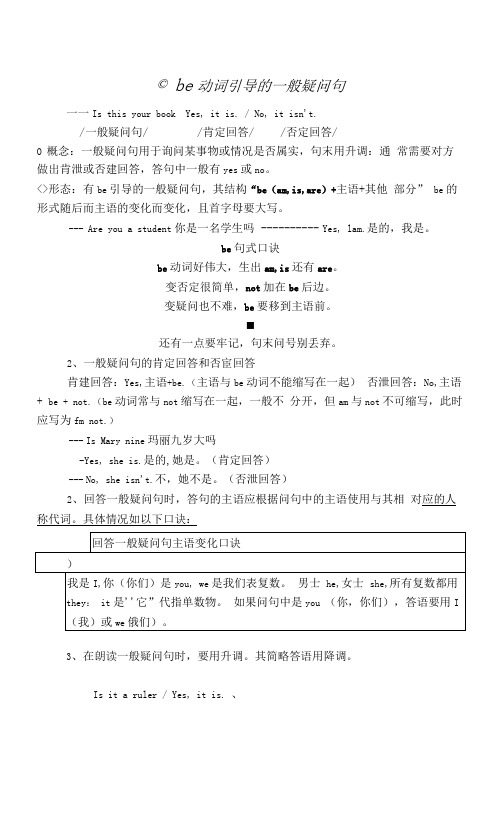
© be动词引导的一般疑问句一一Is this your book Yes, it is. / No, it isn't./一般疑问句/ /肯定回答/ /否定回答/O 概念:一般疑问句用于询问某事物或情况是否属实,句末用升调:通常需要对方做出肯泄或否建回答,答句中一般有yes或no。
<>形态:有be引导的一般疑问句,其结构“be(am,is,are)+主语+其他部分” be的形式随后而主语的变化而变化,且首字母要大写。
--- Are you a student你是一名学生吗---------- Yes, lam.是的,我是。
be句式口诀be动词好伟大,生出am,is还有are。
变否定很简单,not加在be后边。
变疑问也不难,be要移到主语前。
■还有一点要牢记,句末问号别丢弃。
2、一般疑问句的肯定回答和否宦回答肯建回答:Yes,主语+be.(主语与be动词不能缩写在一起)否泄回答:No,主语+ be + not.(be动词常与not缩写在一起,一般不分开,但am与not不可缩写,此时应写为fm not.)--- Is Mary nine玛丽九岁大吗-Yes, she is.是的,她是。
(肯定回答)--- No, she isn't.不,她不是。
(否泄回答)2、回答一般疑问句时,答句的主语应根据问句中的主语使用与其相对应的人称代词。
具体情况如以下口诀:3、在朗读一般疑问句时,要用升调。
其简略答语用降调。
Is it a ruler / Yes, it is. 、◎人称代词的主格、形容词性物主代词和名词性物主代词的人©人称代词主格1、用法:人称代词的主格在句中作主语。
He is a boy.2、人称代词并列作主语时,其顺序为:第二人称一・第三人称一*第一人称You, she and I are in the same class・He and I are good friends.3、复数人称代词并列做主语时,其顺序为:第一人称■►第二人附第三人称We, you and they are Yong Pioneers.我们、你们和他们都是少先队员。
be动词一般疑问句练习(七年级用)
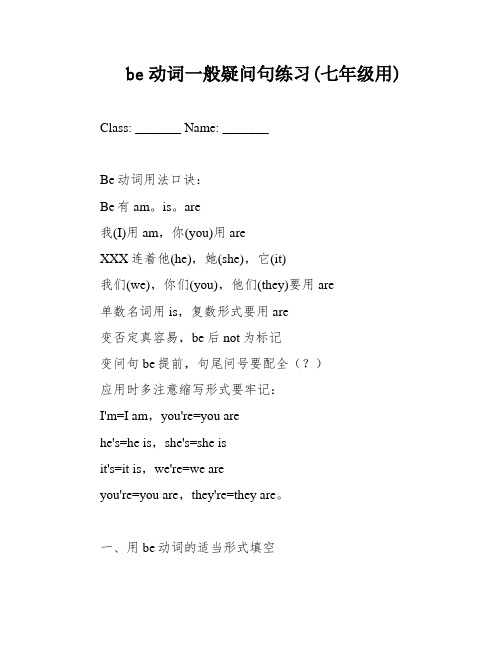
be动词一般疑问句练习(七年级用) Class: _______ Name: _______Be动词用法口诀:Be有am。
is。
are我(I)用am,你(you)用areXXX连着他(he),她(she),它(it)我们(we),你们(you),他们(they)要用are单数名词用is,复数形式要用are变否定真容易,be后not为标记变问句be提前,句尾问号要配全(?)应用时多注意缩写形式要牢记:I'm=I am,you're=you arehe's=he is,she's=she isit's=it is,we're=we areyou're=you are,they're=they are。
一、用be动词的适当形式填空1.I am a boy。
Are you a boy? No。
I am not.2.I am an English XXX now.3.You are a student.You are students.4.The girl is Jack's sister.5.The man is a XXX.The dog is two years old this year. XXX fat.6.It is Children’s Day.7.That is my red pen.8.This is not Wang Fang's pencil.9.These are her books.XXX.11.Helen and Nancy are good friends.12.Mike and Liu Tao are at school.13.You。
he and I are from China.14.All the students are very happy.15.They are glad to see each other.16.Here are some books for you.17.Here XXX.3.Who is your sister。
一般疑问句如何问
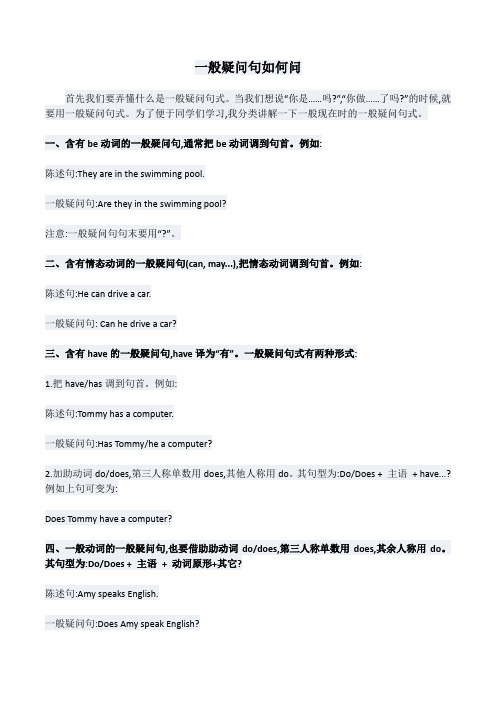
一般疑问句如何问首先我们要弄懂什么是一般疑问句式。
当我们想说“你是……吗?”,“你做……了吗?”的时候,就要用一般疑问句式。
为了便于同学们学习,我分类讲解一下一般现在时的一般疑问句式。
一、含有be动词的一般疑问句,通常把be动词调到句首。
例如:陈述句:They are in the swimming pool.一般疑问句:Are they in the swimming pool?注意:一般疑问句句末要用“?”。
二、含有情态动词的一般疑问句(can, may...),把情态动词调到句首。
例如:陈述句:He can drive a car.一般疑问句: Can he drive a car?三、含有have的一般疑问句,have译为“有”。
一般疑问句式有两种形式:1.把have/has调到句首。
例如:陈述句:Tommy has a computer.一般疑问句:Has Tommy/he a computer?2.加助动词do/does,第三人称单数用does,其他人称用do。
其句型为:Do/Does + 主语+ have...?例如上句可变为:Does Tommy have a computer?四、一般动词的一般疑问句,也要借助助动词do/does,第三人称单数用does,其余人称用do。
其句型为:Do/Does + 主语+ 动词原形+其它?陈述句:Amy speaks English.一般疑问句:Does Amy speak English?知道了如何问话之后,我们来了解一下如何回答一般疑问句。
首先要有人称的改变。
当主语为名词时,在答语中要改成其相应的代词。
另外,答语有两种,肯定的回答(用yes)和否定的回答(用no),否定式常用缩写形式。
现在还是让我们分句型一一说明。
一、一般疑问句含be动词时,用be动词回答,句末用句号。
例如:-Is Mary your sister?-Yes, she is. / No, she isn’t.(缩写)二、一般疑问句含有情态动词(can, may, should等)时,用情态动词回答。
初一英语上册:含be动词一般疑问句考点
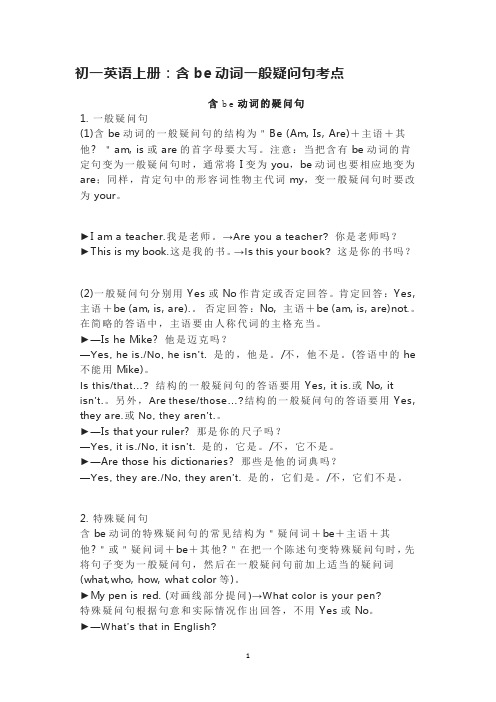
初一英语上册:含be动词一般疑问句考点含be动词的疑问句1. 一般疑问句(1)含be动词的一般疑问句的结构为"Be (Am, Is, Are)+主语+其他? "am, is或are的首字母要大写。
注意:当把含有be动词的肯定句变为一般疑问句时,通常将I变为you,be动词也要相应地变为are;同样,肯定句中的形容词性物主代词my,变一般疑问句时要改为your。
►I am a teacher.我是老师。
→Are you a teacher? 你是老师吗?►This is my book.这是我的书。
→Is this your book? 这是你的书吗?(2)一般疑问句分别用Yes或No作肯定或否定回答。
肯定回答:Yes, 主语+be (am, is, are).。
否定回答:No, 主语+be (am, is, are)not.。
在简略的答语中,主语要由人称代词的主格充当。
►—Is he Mike? 他是迈克吗?—Yes, he is./No, he isn’t. 是的,他是。
/不,他不是。
(答语中的he 不能用Mike)。
Is this/that…? 结构的一般疑问句的答语要用Yes, it is.或No, it isn’t.。
另外,Are these/those…?结构的一般疑问句的答语要用Yes, they are.或No, they aren’t.。
►—Is that your ruler? 那是你的尺子吗?—Yes, it is./No, it isn’t. 是的,它是。
/不,它不是。
►—Are those his dictionaries? 那些是他的词典吗?—Yes, they are./No, they aren’t. 是的,它们是。
/不,它们不是。
2. 特殊疑问句含be动词的特殊疑问句的常见结构为"疑问词+be+主语+其他?"或"疑问词+be+其他?"在把一个陈述句变特殊疑问句时,先将句子变为一般疑问句,然后在一般疑问句前加上适当的疑问词(what,who, how, what color等)。
be动词的一般疑问句10个例句

be动词的一般疑问句10个例句【原创版】目录1.概述:本文主要介绍了 10 个关于 be 动词一般疑问句的例句。
2.be 动词一般疑问句的构成3.例句 1-54.例句 6-105.总结:通过学习这些例句,帮助大家更好地理解和运用 be 动词的一般疑问句。
正文一、概述本文主要介绍了 10 个关于 be 动词一般疑问句的例句。
通过学习这些例句,可以帮助大家更好地理解和运用 be 动词的一般疑问句。
二、be 动词一般疑问句的构成be 动词一般疑问句的构成为:“be 动词(am/is/are)+ 主语 +?”三、例句 1-51.我是李华,你是谁?Am I Li Hua? Who are you?2.她是一个老师,他是一名医生。
Is she a teacher? Is he a doctor?3.他们是张氏家族的一员,你们是王氏家族的一员。
Are they a member of the Zhang family? Are you a member of the Wang family?4.猫是哺乳动物,鸟是脊椎动物。
Is a cat a mammal? Is a bird a vertebrate?5.这个苹果是红色的,那个香蕉是什么颜色的?Is this apple red? What color is that banana?四、例句 6-106.你是哪里人?Where are you from?7.他现在在干嘛?What is he doing now?8.她多大了?How old is she?9.他们结婚了吗?Did they get married?10.你会游泳吗?Can you swim?五、总结通过学习这 10 个关于 be 动词一般疑问句的例句,可以帮助大家更好地理解和运用 be 动词的一般疑问句。
一般疑问句be动词的用法总结 (2)

一般疑问句be动词的用法总结作为英语学习的初级阶段,掌握一般疑问句的用法对于建立语言基础至关重要。
在英语中,be动词是最常见和使用最广泛的一个动词,因此了解其在一般疑问句中的用法以及相应规则是非常必要的。
本文将总结一般疑问句be动词的用法,并提供相关例句进行讲解。
I. 一般疑问句与肯定句形式一般疑问句通常由be动词开头,接着主语后跟其他成分。
其构造方式为将be动词放在主语之前,并且需要倒装主谓位置来形成疑问形式。
下面是具体规则和例子:1. 如果主语是单数第三人称代词(he, she, it)或者使用单数第三人称代词作为补充说明时,则用is作为be动词。
例如:- She is a teacher.- Is she a teacher?2. 如果主语是复数形式(包括复数名词、代词、不可数名词等),则用are作为be动词。
例如:- They are students.- Are they students?3. 如果主语是单数第一人称代词(I)或复数第一、二人称代词(we, you),则用am作为be动词。
例如:- I am happy.- Are you happy?II. 回答一般疑问句回答一般疑问句通常有两种情况:肯定回答和否定回答。
下面将详细讨论每一种情况并提供例句。
1. 肯定回答如果对于所提出的问题表示同意或陈述事实,则可以直接使用"Yes"来回答。
例如:- Is she a teacher? - Yes, she is.2. 否定回答如果对于所提出的问题表示不同意或否认,通常需要使用"no"加上完整的句子来进行否定回答。
例如:- Are they students? - No, they are not students.III. 特殊情况除了一般的疑问句形式外,还存在特殊情况需要特别关注。
下面将讨论这些特殊情况以及相应规则。
1. 简略回答在口语交流中,往往会使用简略回答来表示肯定或否定。
一般疑问句be动词的用法总结

一般疑问句be动词的用法总结一般疑问句是英语中常用的句型之一,通过将谓语动词与主语的顺序反转,并在句末加上问号,来表达询问某种信息或确认某种情况的目的。
在一般疑问句中,be动词被广泛使用,因此对于be动词的正确用法掌握至关重要。
本文将总结一般疑问句中be动词的用法,并举例说明。
一、be动词概述be动词是英语中最基本而常见的助动词之一,包括am, is, are, was, were等形式。
它表示存在、状态、性质等含义,并与主语相呼应。
在一般疑问句中,我们需要根据特定情况来确定使用什么形式的be动词。
二、陈述句变为疑问句1. 如果陈述句中使用了am或is作为be动词,则通过将am或is移到主语前面来构成疑问句。
例如:陈述句:He is a doctor.疑问句:Is he a doctor?2. 如果陈述句中使用了are作为be动词,则通过将are移到主语前面来构成疑问句。
例如:陈述句:They are students.疑问句:Are they students?3. 如果陈述句中使用了was作为be动词,则通过将was移到主语前面来构成疑问句。
例如:陈述句:She was at home.疑问句:Was she at home?4. 如果陈述句中使用了were作为be动词,则通过将were移到主语前面来构成疑问句。
例如:陈述句:You were late.疑问句:Were you late?三、回答一般疑问句当回答一般疑问句时,我们除了可以用yes或no来回答之外,还可以用具体的信息进行回答。
1. 如果问题所询问的情况是肯定的,我们用"Yes, 主语 + be动词的形式"来回答。
例如:Question: Are you ready?Answer: Yes, I am.2. 如果问题所询问的情况是否定的,我们用"No, 主语 + be动词的否定形式"来回答。
一般疑问句be动词的用法
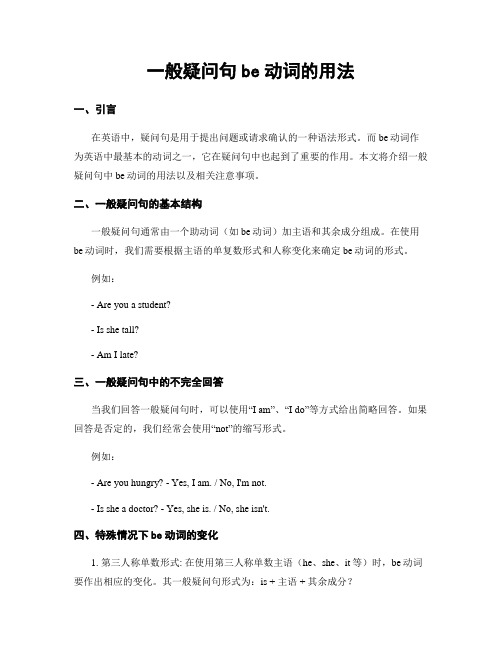
一般疑问句be动词的用法一、引言在英语中,疑问句是用于提出问题或请求确认的一种语法形式。
而be动词作为英语中最基本的动词之一,它在疑问句中也起到了重要的作用。
本文将介绍一般疑问句中be动词的用法以及相关注意事项。
二、一般疑问句的基本结构一般疑问句通常由一个助动词(如be动词)加主语和其余成分组成。
在使用be动词时,我们需要根据主语的单复数形式和人称变化来确定be动词的形式。
例如:- Are you a student?- Is she tall?- Am I late?三、一般疑问句中的不完全回答当我们回答一般疑问句时,可以使用“I am”、“I do”等方式给出简略回答。
如果回答是否定的,我们经常会使用“not”的缩写形式。
例如:- Are you hungry? - Yes, I am. / No, I'm not.- Is she a doctor? - Yes, she is. / No, she isn't.四、特殊情况下be动词的变化1. 第三人称单数形式: 在使用第三人称单数主语(he、she、it等)时,be动词要作出相应的变化。
其一般疑问句形式为:is + 主语 + 其余成分?例如:- Is he happy?- Is she a teacher?2. 过去式形式: 当我们使用一般过去时构建疑问句时,需要注意be动词在各人称上的形式变化。
第一人称和第三人称单数是was,第二人称和其他复数是were。
例如:- Was it cold yesterday?- Were you at home last night?五、特殊情况下的回答有些特殊情况下,我们需要进行额外的注意。
1. 主谓一致:当主语是第三人称单数时,be动词需要用is;当主语是其他形式时,be动词需要用are。
例如:- Are your friends here? - Yes, they are. / No, they aren't.- Is your brother coming with you? - Yes, he is. / No, he isn't.2. have/has的替代:如果主语是have/has结构,则可以使用do/does来代替be 动词。
小学一般疑问句和特殊疑问句和be动词一般过去时讲解及练习

一般疑问句用yes或no答复的疑问句,称为一般疑问句,这种疑问句句末语调多用升调,句末用问号"?〞句型:Be动词 + 主语 + ......"●A: Am I wrong again" 〔我又错了?〕B: Yes, you are 〔wrong again〕. 〔是的,你又错了。
B: No, you aren’t. 〔不,你没错。
〕●A: Is it your bicycle" 〔这辆自行车是你的吗?〕B: Yes, it is. 〔是的,是我的。
〕B: No, it isn’t. 〔不,那不是我的。
〕●A: Are you a student" 〔你是学生吗?〕B:Yes, I am. 〔是的,我是。
〕B: No, I’m not. / No, I am not. 〔不,我不是。
〕●A: Is there any drinks in the fridge"B: Yes, there is. 〔是的,有。
〕B: No, there isn’t. 〔不,没有。
〕●A: Are there any birds in the sky" 〔天空中有鸟吗?〕B: Yes, there are. 〔是的,有。
〕B: No, there aren’t. 〔不,没有。
〕陈述句中有情态动词时,可以直接将它们提前到主语前,构成一般疑问句。
句型:情态动词 + 主语 + 动词原形 + ......"●A: Can you bring me some cakes" 〔你能给我拿些蛋糕来吗?〕B: Yes, I can. 〔是的,可以。
〕B: No, I can’t. / No, I cannot. 〔不,不可以。
〕●A: Must I do it now" 〔我必须现在做吗?〕B: Yes, you must. 〔是的,你必须。
be动词的一般疑问句与回答

be动词的一般疑问句与回答一、简介Be动词是英语语法中最基本的动词之一,用于构成一般现在时、一般过去时以及一般将来时的陈述句、否定句和疑问句。
本文主要探讨be动词的一般疑问句形式及其回答方式。
二、一般疑问句的构成一般疑问句是用于询问陈述句的真实性或提出问题的一种语法形式。
在英语中,be动词在一般疑问句中的使用非常常见。
一般疑问句的构成方式为:将be动词提到主语之前并在句末加上问号。
例如:- You are a student.(陈述句)- Are you a student?(一般疑问句)三、回答一般疑问句回答一般疑问句时,可以使用简短回答或者完整回答的形式。
1. 简短回答简短回答是对一般疑问句使用“是”或“否”进行回答。
格式为:如果陈述句中的be动词是肯定形式,则回答用“Yes, 主语 + be动词.”来表示肯定回答;如果陈述句中的be动词是否定形式,则回答用“No, 主语 + be动词.”来表示否定回答。
例如:- Are you a student?- Yes, I am. / No, I'm not.2. 完整回答完整回答是对一般疑问句使用完整句子进行回答。
格式为:肯定回答时,使用“Yes, 主语 + be动词 + 其他信息.”来回答;否定回答时,使用“No, 主语 + be动词的否定形式 + 其他信息.”来回答。
例如:- Is she a teacher?- Yes, she is. She is a teacher. / No, she isn't. She is not a teacher.四、特殊情况下的回答在回答一般疑问句时,有一些特殊情况需要特别注意。
1. 回答有关第三人称单数的疑问句在回答有关第三人称单数的疑问句时,如果陈述句中的be动词为“is”,则回答用“Yes, 主语 + be动词 + 其他信息.”形式回答;如果陈述句中的be动词为“am”或“are”,则回答用“Yes, 主语 + be动词的原形 +其他信息.”形式回答。
be动词的一般疑问句变化

be动词的一般疑问句变化一般疑问句是使用助动词be来构成的。
be动词有三种形式:am, is和are。
当用be动词提问时,需要将be动词调到句子的主语之前。
具体的一般疑问句形式如下:1. 对于第一人称单数(我):"Am I" 或 "I am" 用中文翻译为"我是"。
2. 对于第三人称单数(他/她/它):"Is he/she/it" 或 "He/She/It is" 用中文翻译为"他/她/它是"。
3. 对于第二人称单数(你):"Are you" 或 "You are" 用中文翻译为"你是"。
4. 对于第一人称和第二人称复数(我们和你们):"Are we" 或 "We are" 用中文翻译为"我们是";"Are you" 或 "You are" 用中文翻译为"你们是"。
5. 对于第三人称复数(他们/她们/它们):"Are they" 或 "They are" 用中文翻译为"他们/她们/它们是"。
这些是be动词构成一般疑问句的方式。
例句如下:1. "Are you a student?"(你是学生吗?)2. "Is he tall?"(他高吗?)3. "Are we late?"(我们迟到了吗?)4. "Are they sisters?"(他们是姐妹吗?)。
练习题:be动词的变化与一般疑问句、否定句

练习题:be动词的变化与一般疑问句、否定句一、be动词的变化be动词是英语中最常用的动词之一,用于表示存在、状态、身份等。
be动词的变化包括以下几个形式:am、is、are、was、were。
1. 第一人称单数形式:am- 例如:I am a student.2. 第三人称单数形式:is- 例如:He is a teacher.- 例如:She is a doctor.3. 第一人称复数形式:are- 例如:We are students.4. 第三人称复数形式:are- 例如:They are doctors.5. 过去时第一、三人称单数形式:was- 例如:He was here yesterday.- 例如:She was tired last night.6. 过去时第一、三人称复数形式:were- 例如:We were at the party yesterday.- 例如:They were happy to see each other.二、一般疑问句的构成与回答一般疑问句是用于询问陈述句的真假或事实的句型。
构成一般疑问句的方法是将be动词放在句首,紧接主语,然后用问号结尾。
例如:- Are you a student?(你是学生吗?)- Is he a teacher?(他是老师吗?)对于一般疑问句的回答可以采用以下几种方式:1. 肯定回答:Yes, 主语 + be动词。
- 例如:Yes, I am.(是的,我是。
)- 例如:Yes, he is.(是的,他是。
)2. 否定回答:No, 主语 + be动词 + not。
- 例如:No, I am not.(不,我不是。
)- 例如:No, he is not.(不,他不是。
)三、否定句的构成否定句用于表示否定的陈述或命令,使用be动词的否定形式。
构成否定句的方式是在be动词后加not。
例如:- I am not a student.(我不是学生。
Be动词和一般疑问句
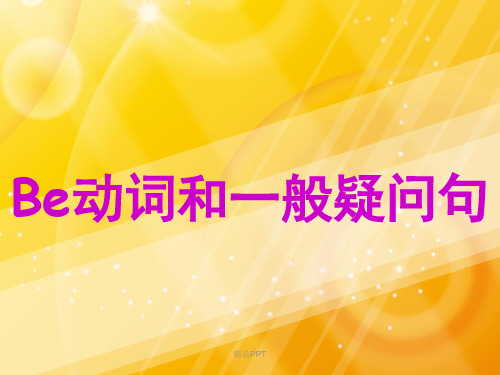
精品PPT
有Be动词的陈述句改为一般疑问句的 基本步骤(2)
I am Kangkang.
Are you Kangkang?
①找出be动词 ②将be动词放到最前面
I am Mary. Am I Mary.
③主语是第一人称I改为 第二人称you,对应 am改成are(my改成
your)
Are you Mary.
④句号改成问号
Are you Mary?
精品PPT
一般疑问(Simple Quesiton)
陈述句
一般疑问句
It is a fish.
Is it a fish?
They are fish.
Are they fish?
This is your book. Is this your book?
I am a student.
精品PPT
Can you speak English?
陈述句:__I_c_a_n__s_p__e_a_k__E_n_g__li_s_h. 肯定回答:___Y_e_s_,_I__c_a_n_.______ 否定回答:__N__o_,_I__c_a_n_n__o_t_. ____ 缩写形式: No, I can’t.
精品PPT
有Be动词的陈述句改为一般疑问句的 基本步骤(1)
He is Kangkang.
Is he Kangkang?
①找出be动词
②将be动词放到最前面
③首字母大写,原来的首 字母改掉,其他照抄
④句号改成问号
She is Mary. is She Mary. Is she Mary.
Is Mary?
精品PPT
She is she isn’t
小升初英语语法专题Be动词引导的一般疑问句

Yes,I am .
一二人称要互换,人称换了, 对应的Be动词也要发生变化。
Are you going to run?
No,I'm not.
小试牛刀
Was it a big city then?
肯定回答:
Yes, it was
.
否定回答:
No, it wasn't
一般疑问句只有两种回答:
肯定回答:Yes,主语+Be动词的肯定式. 否定回答:No,主语+Be动词的否定式. 温馨提示:主语一般用代词:I,we,he,she,it,they... 当一般疑问句主语是第二人称时,回答要换成第一 人称:即“一二人称要互换”。
3.Be 动词引导的疑问句如何作答(3)
5.小试牛刀
请将下列句子变成一般疑问句,并作答。 2.I'm watching TV now. 一般疑问句: Are you watching TV now? 肯定回答: Yes, I am. 否定回答: No, I'm not.
5.小试牛刀
请将下列句子变成一般疑问句,并作答。 3.Lucy and Lily are going to the park. 一般疑问句: Are Lucy and Lily going to the park? 肯定回答: Yes,they are. 否定回答: No, they aren't.
小升初英语语法专题 Be 动词引导的一般疑问句
一.Be动词有哪些
am
Be动词
is
are
was were
2.常见的Be动词引导的一般疑问句
1.Is it very tall? 2.Are you going to run? 3.Are they hens? 4.Were you at home yesterday? 5.Was he strong then?
Be动词和一般疑问句PPT课件

6. He
my father. She
my mother
. They
both doctors .
A. is is are B. am is are C. is is am
精选PPT课件
6
I’m Alice Wang. I’m a pupil. I’m nine years old. I’m tall. Nice to meet you.
I am Mary. Am I Mary.
③主语是第一人称I改为 第二人称you,对应 am改成are(my改成
your)
Are you Mary.
④句号改成问号
Are you Mary?
精选PPT课件
15
一般疑问(Simple Quesiton)
陈述句
一般疑问句
It is a fish.
Is it a fish?
肯定回答:__Y_e_s_,_s_h_e__is_.________
否定回答:__N__o_, _s_h_e__is__n_o_t._____
缩写形式: No, she isn’t.
精选PPT课件
19
She _i_s__ from Canada. 一般疑问句:_I_s__s_h_e__f_r_o_m___C__a_nada? 肯定回答:_____Y_e_s__,_s_h__e__is__. __ 否定回答:___N__o_,_s__h_e__i_s__n_o_t_.
2. 如果肯定句中有be动词(am, is, are, was, were ) , 或 情 态 动 词 ( will,can, could, must, 等),只需将be动词或情态 动词之后加not即可得到相应的否定句。
含有动词be动词地一般疑问句
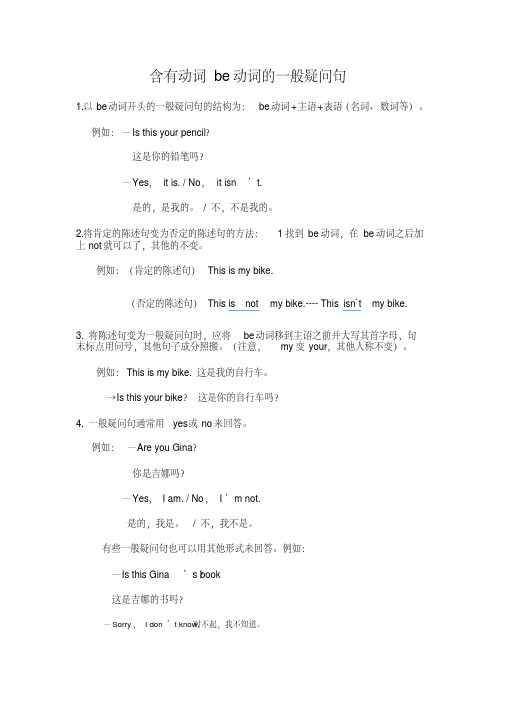
含有动词be动词的一般疑问句1.以be动词开头的一般疑问句的结构为:be动词+主语+表语(名词、数词等)。
例如:—Is this your pencil?这是你的铅笔吗?—Yes,it is. / No,it isn’t.是的,是我的。
/ 不,不是我的。
2.将肯定的陈述句变为否定的陈述句的方法:1找到be动词,在be动词之后加上not就可以了,其他的不变。
例如:(肯定的陈述句)This is my bike.(否定的陈述句)This is not my bike.---- This isn`t my bike.3. 将陈述句变为一般疑问句时,应将be动词移到主语之前并大写其首字母,句末标点用问号,其他句子成分照搬。
(注意,my变your,其他人称不变)。
例如:This is my bike. 这是我的自行车。
→Is this your bike?这是你的自行车吗?4. 一般疑问句通常用yes或no来回答。
例如:—Are you Gina?你是吉娜吗?—Yes,I am. / No,I’m not.是的,我是。
/ 不,我不是。
有些一般疑问句也可以用其他形式来回答。
例如:?—Is this Gina’s book这是吉娜的书吗?—Sorry,I don’t know.对不起,我不知道。
强化题(同步导学上)P5二.单项选择 1 3 4 7 题P6三.按要求完成句子 1 2 4 题P7二.单项选择 2 8 题P9三.按要求完成句子 1 2 3 题;一.单项选择 1 2 4 5 题P10 第8 9 题;三按要求完成句子 3 4 5 题P11二.单项选择 3 5 题P12 第7 10 题一.单项选择 1 2 3 题。
- 1、下载文档前请自行甄别文档内容的完整性,平台不提供额外的编辑、内容补充、找答案等附加服务。
- 2、"仅部分预览"的文档,不可在线预览部分如存在完整性等问题,可反馈申请退款(可完整预览的文档不适用该条件!)。
- 3、如文档侵犯您的权益,请联系客服反馈,我们会尽快为您处理(人工客服工作时间:9:00-18:30)。
8.He has a new bag.____color is blue. (it’s/its)
9._____and I often play football.(he/his)
人称代词(主)
am
Be动词 is are
一般疑问句
be be
be
I we our my
?
1.His mother is a nurse. 2.I am a teacher. 3.My name is Jack.
4.Peter and I are good friends. ___balls are the same.(we/our)
5.Look at that girl.____skirt is nice. (her/she)
6.____T-shirts are dirty.(we/our)
7.Tony and Leo,____are great.(your/you)
4.Our balls are the same. 5.Tony and Leo are good friends. 6.My ticket is on the table.
否定句 Be动词
not
1.His mother is a nurse. 2.I am a teacher. 3.My name is Jack.
复习
代词
人称代词(主) 形容词性 物主代词
人称分为几类?
人称
第一人称 第二人称 第三人称
Hale Waihona Puke 主格形容词性物主 代词
I we you you he she it they
my our your your his her its their
形容词性物主代词
特点1.表示谁谁的· · ·· · ·
特点2.
形物代
名词
Choose and fill.
1.Eric is a boy._____mother is a nurse. (He/His) 2.I am a teacher._____name is Jack. (My/I) 3.Sam, come here. Is this____pencil? (you/your)
4.Our balls are the same.
5.Tony and Leo are good friends. 6.My ticket is on the table.
